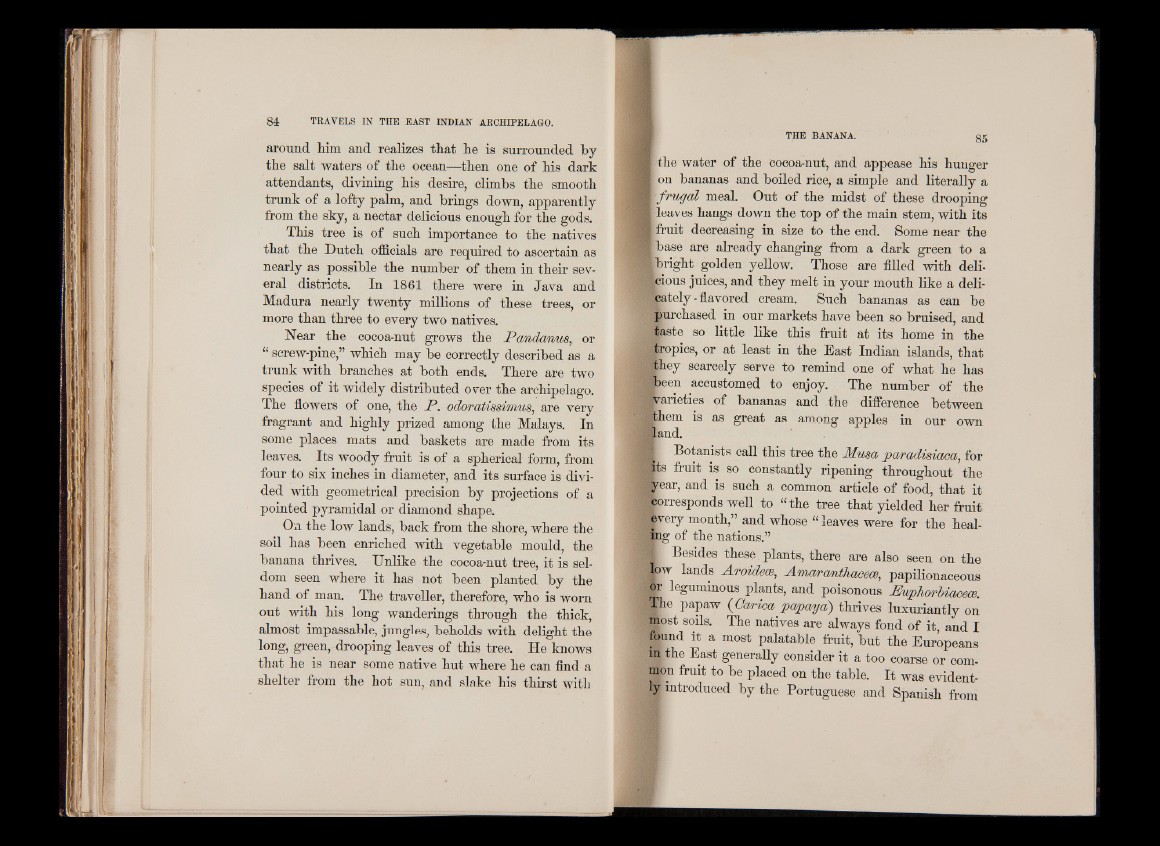
around Mm and realizes tliat lie is surrounded by
the salt waters of the ocean—then one of his dark
attendants, divining his desire, climbs the smooth
trunk of a loffcy palm, and brings down, apparently
from the sky, a nectar delicious enough for the gods.
TMs tree is of such importance to the natives
that the Dutch officials are required to ascertain as
nearly as possible the number of them in their several
districts. In 1861 there were in Java and
Madura nearly twenty millions of these trees, or
more than three to every two natives.
Near the cocoa-nut grows the Pandcmus, or
“ screw-pine,” which may be correctly described as a
trunk with branches at both ends. There are two
species of it widely distributed over the archipelago.
The flowers of one, the P . odoratissimus, are very
fragrant and highly prized among the Malays. In
some places mats and baskets are made from its
leaves. Its woody fruit is of a spherical form, from
four to six inches in diameter, and its surface is divided
with geometrical precision by projections of a
pointed pyramidal or diamond shape.
On the low lands, back from the shore, where the
soil has been enriched with vegetable mould, the
banana thrives. Unlike the cocoa-nut tree, it is seldom
seen where it has not been planted by the
hand of man. The traveller, therefore, who is worn
out with his long wanderings through the thick,
almost impassable, jungles, beholds with delight the
long, green, drooping leaves of this tree. He knows
that he is near some native hut where he can find a
shelter from the hot sun, and slake his thirst with
■ the water of the cocoa-nut, and appease Ms hunger
■ on bananas and boiled rice, a simple and literally a
wtfrugal meal. Out of the midst of these drooping
I leaves hangs down the top of the main stem, with its
I fruit decreasing in size to the end. Some near the
■base are already changing from a dark green to a
■bright golden yellow. Those are filled with deli-
■cious juices, and they melt in your mouth like a delicately
flavored cream. Such bananas as can be
purchased in our markets have been so bruised, and
taste so little like this fruit at its home in the
tropics, or at least in the East Indian islands, that
they scarcely serve to remind one of what he has
P>een accustomed to enjoy. The number of the
¡¡varieties of bananas and the difference between
Hhem is as great as among apples in our own
land.
Botanists call this tree the Atusa pa/radisiaca, for
its fruit is so constantly ripemng tMoughout the
year, and is such a common article of food, that it
corresponds well to “ the tree that yielded her fruit
every month,” and whose “ leaves were for the healin
g of the nations.”
Besides these plants, there are also seen on the
§)w lands Aroideai, Amcvrcmthacece, papilionaceous
Kj leguminous plants, and poisonous Psuphorbiacece.
The papaw (Carica papaya) thrives luxuriantly on
most soils. The natives are always fond of it, and I
found it a most palatable fruit, but the Europeans
m the East generally consider it a too coarse or common
fruit to be placed on the table. It was evident-
■ introduced by the Portuguese and Spanish from